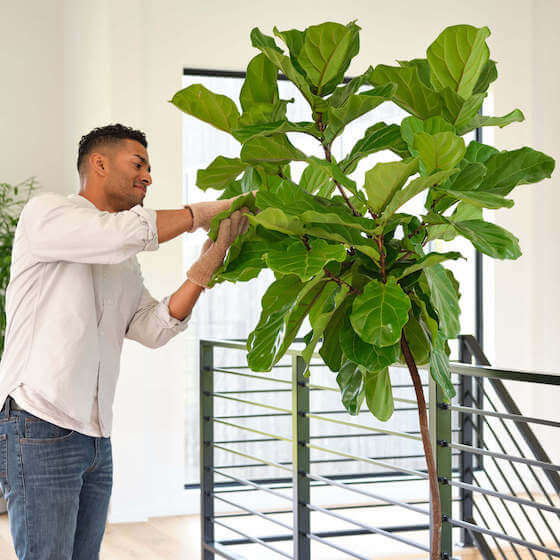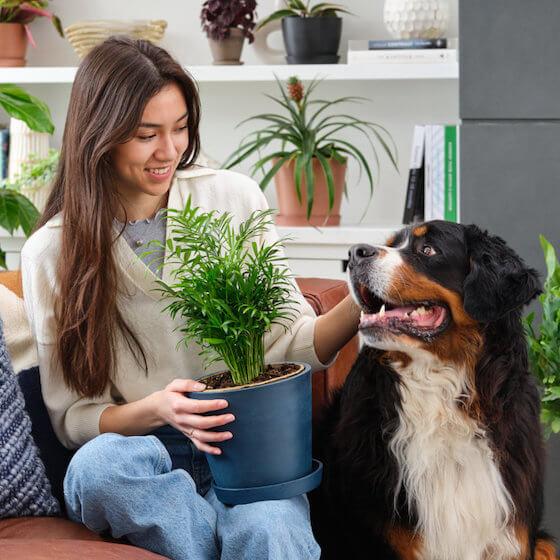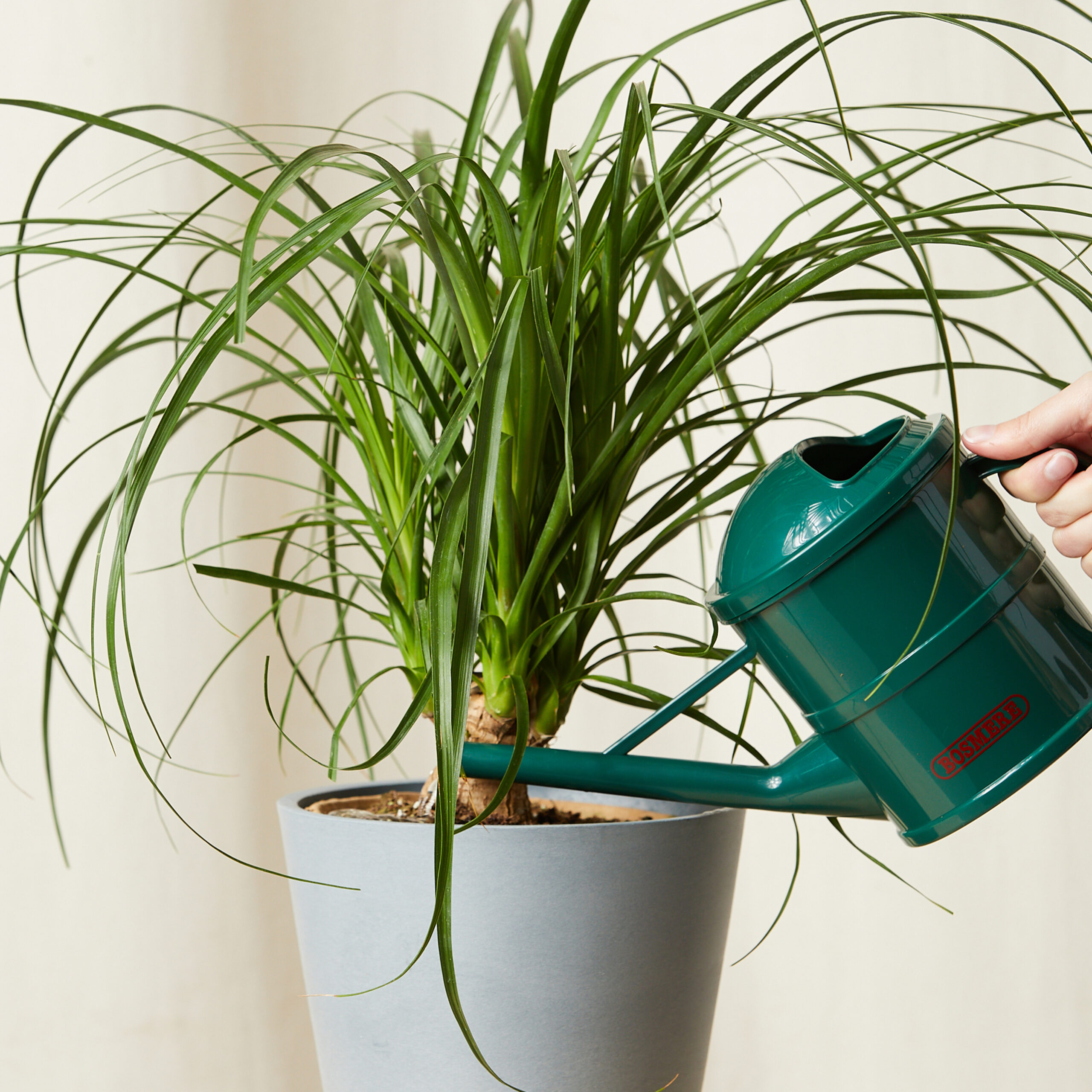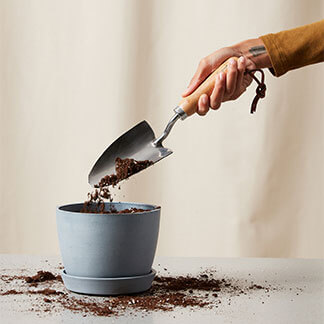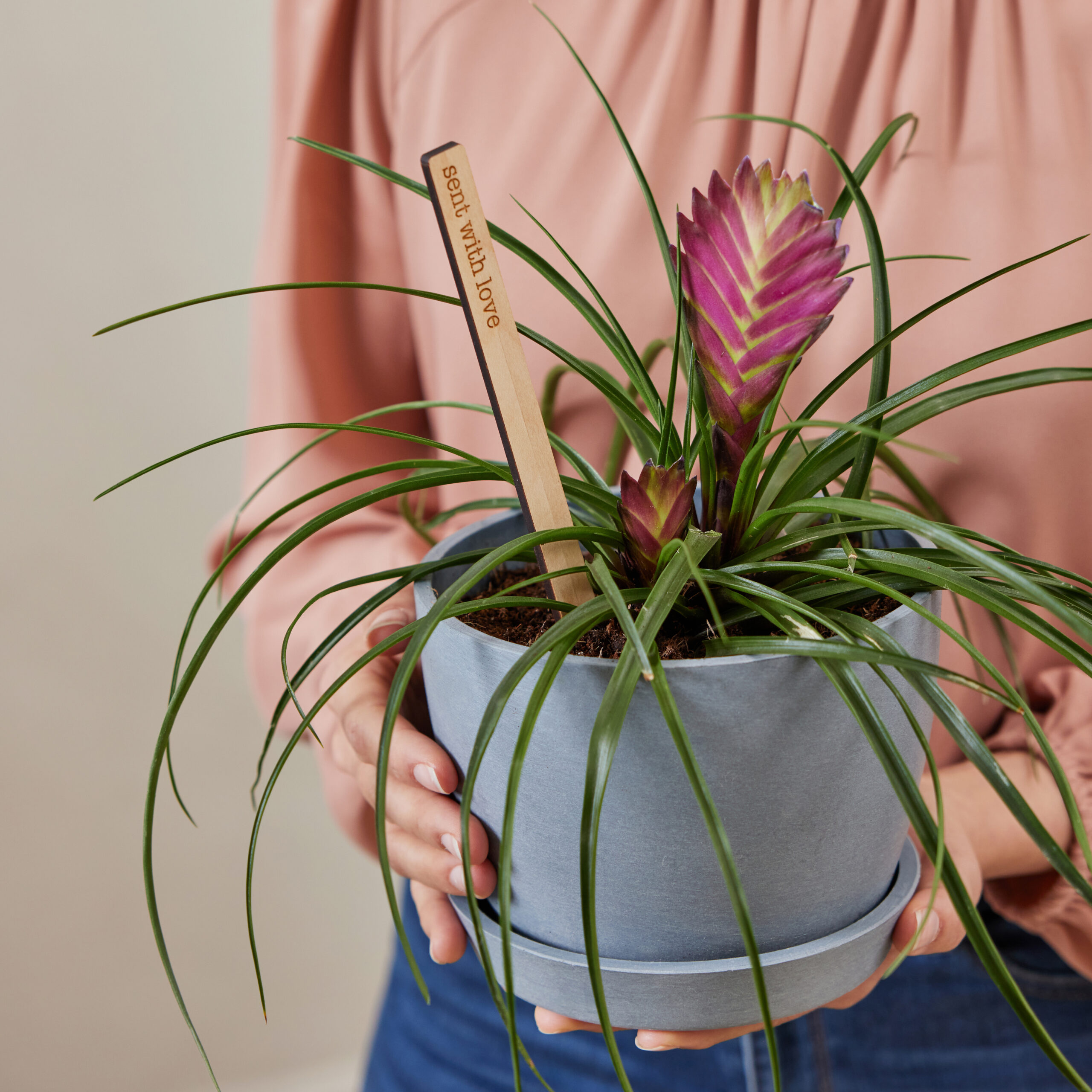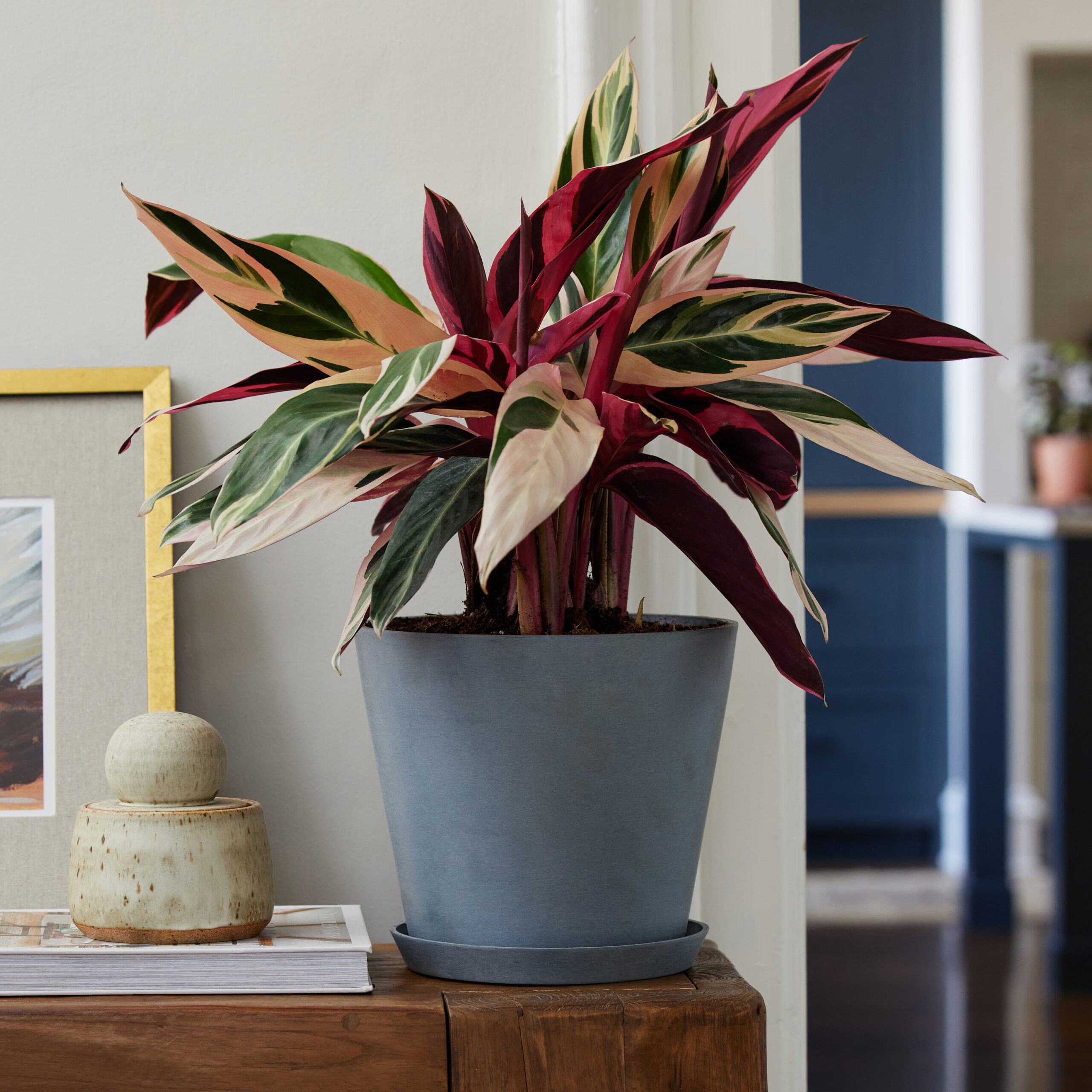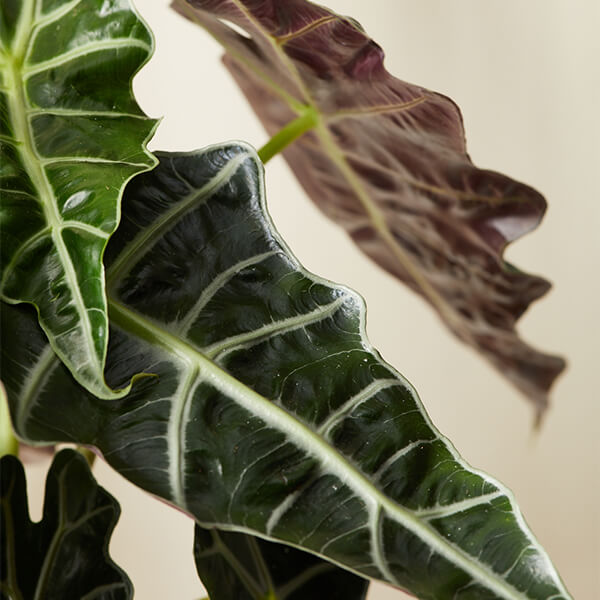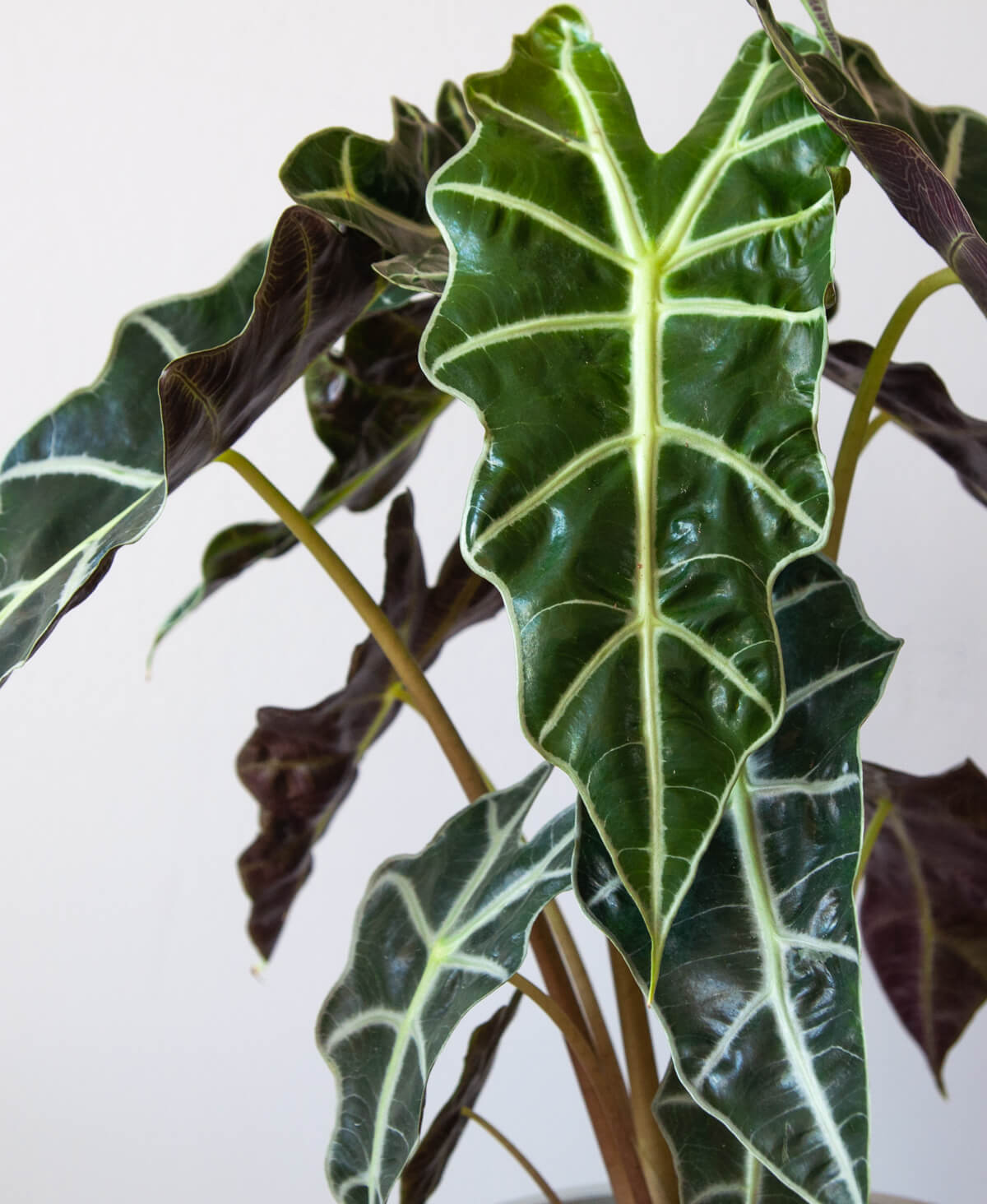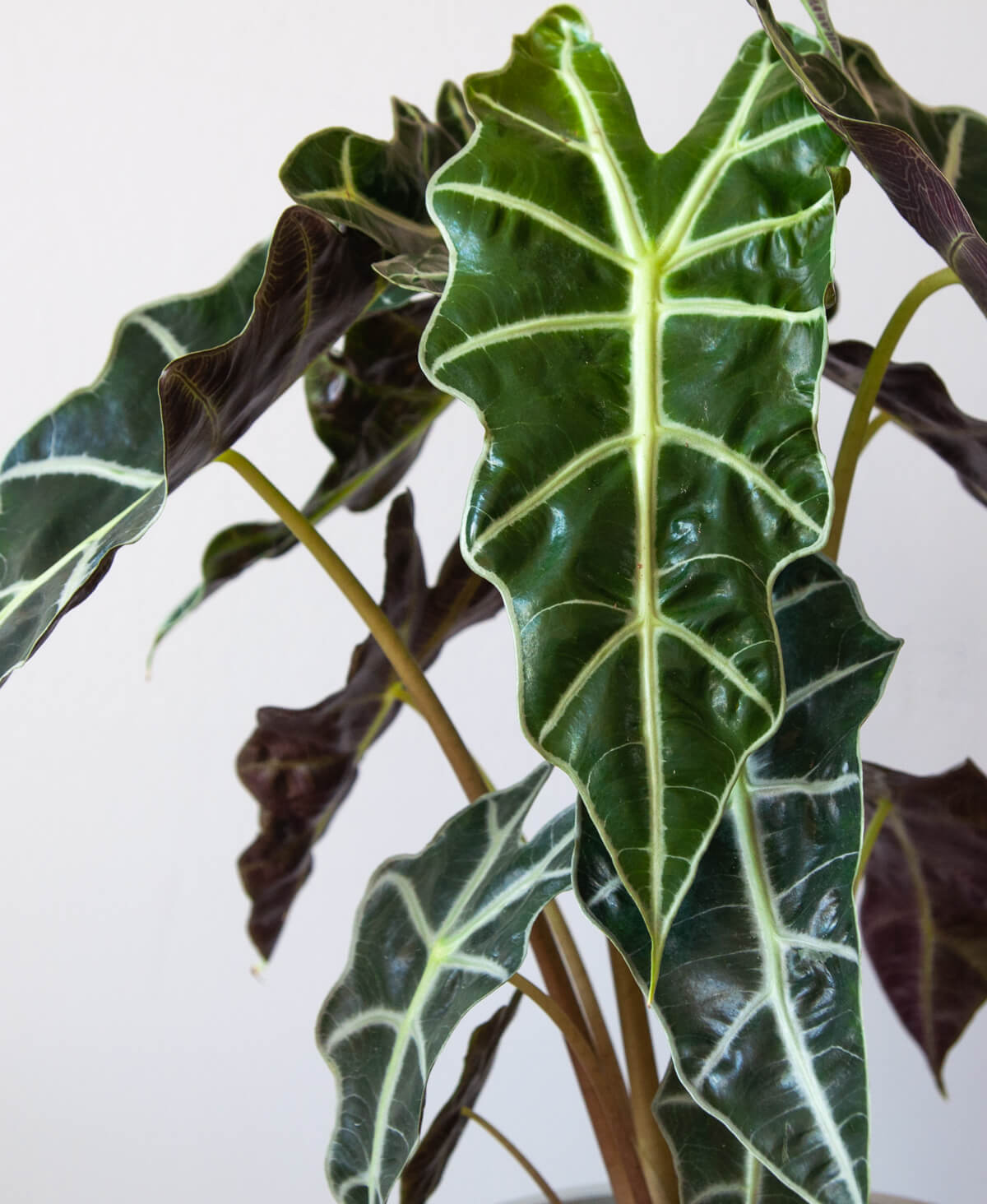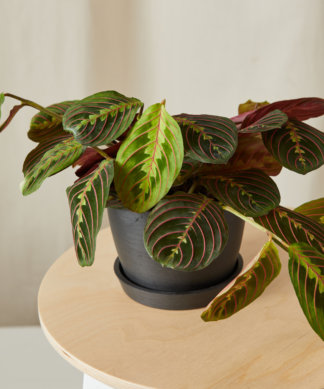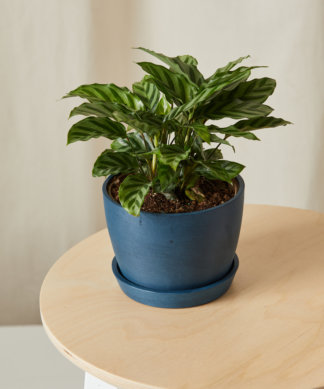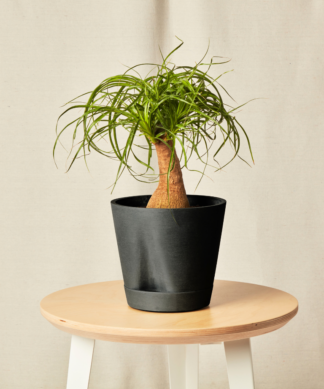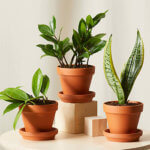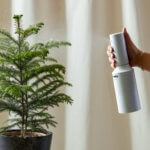How to care for your Alocasia
Use these instructions to care for an Alocasia. This guide will tell you how to water an Alocasia; its light, temperature, humidity preferences and any additional care it might need to help it grow.
Alocasia Azlanii
Indirect light or dappled shade provide the best illumination for your Alocasia Plant. In fact, your plant would thrive sitting next to an east or west-facing window as long the sun exposure doesn’t scorch the leaves. In a room that lacks natural light, you might consider placing a grow light nearby.
Your Alocasia Plant requires watering only when its soil is 25% to 50% dry. Since this plant is high-risk for root rot, you’ll need to ensure proper drainage by watching the bottom of the pot and throwing out any water that’s left standing in the saucer. On another note, be sure to watch out for spots on the leaves, as this is a sign that your plant does not like tap water. If this occurs, you may need to fill your watering can with rain or distilled water.
To guarantee exceptional Alocasia Plant care results, place your plant in a humid room, like your bathroom or kitchen. Alocasia prefers high humidity, and regular misting or using a humidifier or pebble tray would be helpful.
Your Alocasia enjoys warm temperatures between 65℉-85℉. While it barely tolerates 60℉, you should never let the temperature decrease. Also keep your plant away from drafts and vents.
Monthly feedings are important, but you can also fertilize your plant every two months, depending on its condition. You can use a slow-release pellet formula or a liquid 20-20-20 fertilizer measured at half-strength and diluted in water. Make sure the soil is damp before fertilizing your plant.
The Alocasia plant is mildly toxic to pets and humans. Ingesting it causes stomach issues and sometimes vomiting.
Your Alocasia will go through a dormant period in the winter months. During dormancy, keep your Alocasia in a warmer spot in your home. Reduce the frequency of watering but do not allow the potting mix to completely dry out. The plant will naturally come out of dormancy in the spring when you’ll notice new growth. At this time, begin to water the plant more frequently and give it its first spring fertilizer application. If your Alocasia is in need of a trim, clean up your plant using clean, sharp Plant Snips.
Alocasia Black Velvet
Your Alocasia Black Velvet will thrive in a spot with medium to bright indirect light. Avoid direct sunlight, which can cause leaf scorch. It is not tolerant of low-light situations so consider using a Grow Light.
Water your Alocasia when 25-50% of the soil volume is dry. Water until liquid flows through the drainage hole at the bottom of the pot and discard any water that has accumulated in the saucer. Alocasia is susceptible to root rot, so avoid overwatering.
Your Alocasia prefers a spot with ample humidity. Mist the leaves regularly using a Mister, place a humidifier nearby, or use a pebble tray to raise the humidity.
Your Alocasia prefers warm temperatures between 65–85°F. Avoid cold drafts and sudden temperature changes.
Feed every month in the spring and summer with half-strength, all-purpose indoor plant fertilizer such as our All Purpose Fertilizer (20-20-20). No fertilizer is needed in the fall and winter months. Before applying, make sure the soil is damp to avoid burning the roots.
Alocasias are mildly toxic to pets and humans. Typically, ingestion will cause mouth and stomach irritation and possible vomiting.
Your Alocasia will go through a dormant period in the winter months. During dormancy, keep your Alocasia in a warmer spot in your home. Reduce the frequency of watering but do not allow the potting mix to completely dry out. The plant will naturally come out of dormancy in the spring, when you’ll notice new growth. At this time, begin to water the plant more frequently and give it its first spring fertilizer application. If your Alocasia is in need of a trim, clean up your plant using clean, sharp Plant Snips.
Alocasia Lutea Golden
Your Golden Alocasia will thrive in bright indirect light. Never allow your plant to stand in the direct sunlight—the leaves will burn. If you don’t have an ideal location for your Alocasia, use a Grow Light.
Water your Alocasia when 25-50% of the soil volume is dry. Water until liquid flows through the drainage hole at the bottom of the pot and discard any water that has accumulated in the saucer. Alocasia is susceptible to root rot, so avoid overwatering.
Your Alocasia prefers a humid environment so mist often. Mist the leaves regularly using a Mister, place a humidifier nearby, or use a pebble tray to raise the humidity.
Your Alocasia prefers warm temperatures between 65–85°F. Avoid cold drafts and sudden temperature changes.
Feed every month in the spring and summer with half-strength, all-purpose indoor plant fertilizer, such as our All Purpose Fertilizer (20-20-20). No fertilizer is needed in the fall and winter months. Before applying, make sure the soil is damp to avoid burning the roots.
Alocasias are mildly toxic to pets and humans. Typically, ingestion will cause mouth and stomach irritation and possible vomiting.
Your Golden Alocasia will go through a dormant period when light levels and temperatures are reduced in the winter months. During dormancy, keep your Alocasia in a warmer spot in your home and reduce the watering but do not allow it to completely dry out. You will see it perk up again in the spring. If your Alocasia is in need of a trim, clean up your plant using clean, sharp Plant Snips.
Alocasia Pink Dragon
Your Alocasia Pink Dragon will thrive in a spot with bright, indirect, filtered light. Never allow this plant to stand in the direct sunlight—the leaves will burn. If you don’t have a location with ideal lighting for your Alocasia, use a Grow Light.
Water your Alocasia when 25-50% of the soil volume is dry. Water until liquid flows through the drainage hole at the bottom of the pot and discard any water that has accumulated in the saucer. Alocasia is susceptible to root rot, so avoid overwatering.
Your Alocasia prefers a humid environment so mist often. Mist the leaves regularly using a Mister, place a humidifier nearby, or use a pebble tray to raise the humidity.
Your Alocasia prefers warm temperatures between 65–85°F. Avoid cold drafts and sudden temperature changes.
Feed every month in the spring and summer with half-strength, all-purpose indoor plant fertilizer, such as our All Purpose Fertilizer (20-20-20). No fertilizer is needed in the fall and winter months. Before applying, make sure the soil is damp to avoid burning the roots.
Alocasias are mildly toxic to pets and humans. Typically, ingestion will cause mouth and stomach irritation and possible vomiting.
Your Alocasia Pink Dragon will go through a dormant period in the winter months. During dormancy, keep your Alocasia in a warmer spot in your home and reduce the watering but do not allow it to completely dry out. You will see it perk up again in the spring. If your Alocasia is in need of a trim, clean up your plant using clean, sharp Plant Snips.
Alocasia Polly
Your Alocasia Polly will thrive in a spot with bright, indirect, filtered light. Never allow this plant to stand in the direct sunlight—the leaves will burn. If you don’t have an ideal location for your Alocasia, use a Grow Light.
Water your Alocasia when 25-50% of the soil volume is dry. Water until liquid flows through the drainage hole at the bottom of the pot and discard any water that has accumulated in the saucer. Alocasia is susceptible to root rot, so avoid overwatering.
Your Alocasia prefers a humid environment so mist often. Mist the leaves regularly using a Mister, place a humidifier nearby, or use a pebble tray to raise the humidity.
Your Alocasia prefers warm temperatures between 65–85°F. Avoid cold drafts and sudden temperature changes.
Feed every month in the spring and summer with half-strength, all-purpose indoor plant fertilizer, such as our All Purpose Fertilizer (20-20-20). No fertilizer is needed in the fall and winter months. Before applying, make sure the soil is damp to avoid burning the roots.
Alocasias are mildly toxic to pets and humans. Typically, ingestion will cause mouth and stomach irritation and possible vomiting.
Your Alocasia Polly will go through a dormant period in the winter months. During dormancy, keep your Alocasia Polly in a warmer spot in your home and reduce the watering but do not allow it to completely dry out. You will see it perk up again in the spring. If your Alocasia is in need of a trim, clean up your plant using clean, sharp Plant Snips.
Alocasia Purple Sword
Your Alocasia Purple Sword will thrive in bright, indirect light. Never allow this plant to stand in the direct sunlight—the leaves will burn. If you don’t have an ideal location for your Alocasia, use a Grow Light.
Water your Alocasia when 25-50% of the soil volume is dry. Water until liquid flows through the drainage hole at the bottom of the pot and discard any water that has accumulated in the saucer. Alocasia is susceptible to root rot, so avoid overwatering.
Your Alocasia prefers a humid environment so mist often. Mist the leaves regularly using a Mister, place a humidifier nearby, or use a pebble tray to raise the humidity.
Your Alocasia prefers warm temperatures between 65–85°F. Avoid cold drafts and sudden temperature changes.
Feed every month in the spring and summer with half-strength, all-purpose indoor plant fertilizer, such as our All Purpose Fertilizer (20-20-20). No fertilizer is needed in the fall and winter months. Before applying, make sure the soil is damp to avoid burning the roots.
Alocasias are mildly toxic to pets and humans. Typically, ingestion will cause mouth and stomach irritation and possible vomiting.
Your Alocasia Purple Sword will go through a dormant period when light levels and temperatures are reduced in the winter months. During dormancy, keep your plant in a warmer spot in your home and reduce the watering but do not allow it to completely dry out. You will see it perk up again in the spring. If your Alocasia is in need of a trim, clean up your plant using clean, sharp Plant Snips.
